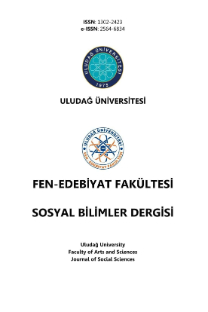Edwin Muir’in Travma, Sürgün ve Kayıp Şiirlerinde Sığınma Mekânları
Son yıllarda travma alanında yapılan çalışmalar, travmanın nasıl tanımlandığını, tarihsel olay ve şartların sanat üzerindeki etkisini araştırmaktadır; örneğin, Modernizm I. Dünya Savaşı sonrası ortaya çıkan travma, yabancılaşma ve yalnızlık temalarını yansıtır. Bu bağlantı 1887 yılında doğmuş ve yirminci yüzyılın pek çok büyük olayına tanıklık etmiş Edwin Muir’in şiirinde de görülebilir. Fakat Muir’in travma anlayışı sadece I. Dünya Savaşı ile sınırlı değildir; aynı zamanda, insanların ve mekânların kaybı da onun şiirini etkilemiştir. Travmayla birlikte, kayıp ve göç olayları da Muir’i mitik ve nostaljik bir geçmişe yöneltmiştir. Başka bir şehre göç ettiği için şairin çektiği ıstırap, belirli mekânlarla özdeşleşmiştir, bu sebeple Muir’in şiiri mekânsal özellikler üzerinde durur. Bu bakımdan, genellikle nostalji duygularına yol açtığı için travma Muir’in şiirini anlamak için merkezi bir rol oynar. Muir’in nostalji anlayışıyla bağlantılı travmasının merkezinde hem tarihsel hem de mitik bir mekânsal yoğunlaşma yer alır. Dolayısıyla bu çalışma, Muir’in kişisel ve genel travmasına bağlı olarak nostalji ve mekân arasındaki başlıca bağlantıyı inceleyecektir.
SPACES OF SANCTUARY IN EDWIN MUIR’S POEMS OF TRAUMA, EXILE AND LOSS
Trauma studies have recently explored the influence of historical event andcircumstance on art and how trauma is portrayed; for example, Modernism representsthe embodiment of the theme of trauma, alienation and loneliness after the FirstWorld War. This connection is also discernible in the poetry of Edwin Muir who wasborn in 1887 and witnessed various great events of the twentieth century. However,Muir’s sense of trauma was not limited to only WWI, but the loss of people and placesinfluenced his verse as well. The theme of loss and migration led Muir to a mythicaland nostalgic past as a response to trauma. Due to migration to another city, hisstruggle with agony was blended with certain places; hence, his poetry elaborates onspatial aspects. In this regard, as it often does lead to feelings of nostalgia, traumabecomes central to understanding Muir’s poetry. In the centre of Muir’s traumarelated to his abiding sense of nostalgia is a concentration on places, both historicaland mythical. Therefore, this paper will explore the main connection betweennostalgia and space in relation to Muir’s personal and collective trauma.
___
- Bachelard, Gaston (1994). The Poetics of Space. Trans. Maria Jolas. Boston: Beacon Press.
- Butter, Peter H. (1966). Edwin Muir: Man and Poet. Edinburgh: Oliver & Boyd.
- Caruth, Cathy (1996). Unclaimed Experience: Trauma, Narrative, and History. Baltimore: The Johns Hopkins UP.
- Eliade, Mircea (1961). Images and Symbols: Studies in Religious Symbolism. Trans. Philip Mairet. New York: Sheed & Ward.
- Hall, John Clive (1956). Edwin Muir. London: Longmans, Green & Co.
- Hoffman, Daniel (1967). Barbarous Knowledge: Myth in the Poetry of Yeats, Graves, and Muir. New York: Oxford UP.
- Huberman, Elizabeth (1972). “Initiation and Tragedy: A New Look at Edwin Muir’s ‘The Gate’”, PMLA, Vol. 87, Iss. 1, p. 75-79.
- Huberman, Elizabeth (1971). The Poetry of Edwin Muir: The Field of Good and Ill. New York: Oxford U P.
- Kaplan, E. Ann (2005). Trauma Culture: The Politics of Terror and Loss in Media and Literature. New Brunswick: Rutgers UP.
- Macrae, Alasdair D. F. (1995). “Edwin Muir: Reading Eternity’s Secret Script” British Poetry, 1900-50: Aspects of Tradition. Eds. Gary Day and Brian Docherty. Basingstoke: Macmillan P.
- Muir, Edwin (1954). An Autobiography. London: The Hogarth Press.
- Muir, Edwin (1960). Collected Poems: 1921-1958. London: Faber and Faber.
- Trauma (1993). Webster’s Third New International Dictionary. 3 rd ed.,p. 2432.
- Tuan, Yi-Fu (1977). Space and Place: The Perspective of Experience. Minneapolis: U of Minnesota P.
- van der Kolk, Bassel A. and Onno van der Hart (1995). “The Intrusive Past: The Flexibility of Memory and the Engraving of Trauma” Trauma: Explorations in Memory. Ed. Cathy Caruth. Baltimore: The Johns Hopkins UP., p. 158-182.
- ISSN: 1302-2423
- Yayın Aralığı: Yılda 2 Sayı
- Başlangıç: 1999
- Yayıncı: Bursa Uludağ Üniversitesi
Sayıdaki Diğer Makaleler
İKİNCİL TRAVMATİK STRESİN MESLEK ELEMANLARI ÜZERİNDEKİ ETKİLERİ: BİR DERLEME ÇALIŞMASI
MEN AVOIDING LOVE IN JOSEPH CONRAD’S VICTORY AND YUSUF ATILGAN’S AN IDLE MAN
KANT’IN ETİĞİNDE ÖZERKLİK VE EREK
J. OFFENBACH VE “GÜZEL HELEN” OPERETİ
Edwin Muir’in Travma, Sürgün ve Kayıp Şiirlerinde Sığınma Mekânları
BALKAN GÖÇMENLERİNİN SİVİL TOPLUM KURULUŞLARINA İLGİSİ
Joseph Conrad’ın Zafer ve Yusuf Atılgan’ın Aylak Adam Romanlarında Aşktan Kaçınan Erkekler
İZLEK BAĞIMLILIĞI TEORİSİ VE YAPAY ZEKÂ TEKNOLOJİSİNE GEÇİŞ: HİZMET ENDÜSTRİSİ ÜZERİNE BİR ANALİZ
